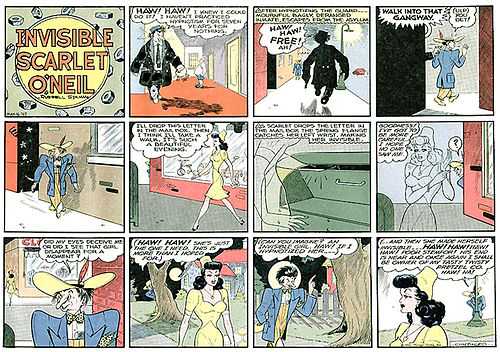Invisible Scarlet O'Neil
From Wikipedia, the free encyclopedia

Russell Stamm's Invisible Scarlet O'Neil (May 16, 1943)
Invisible Scarlet O'Neil is an American comic strip written and drawn by Russell Stamm, who had previously been an assistant to Chester Gould on Dick Tracy.[1] Published by the Chicago Times, it ran from June 3, 1940 to 1956.
It focused on Scarlet O'Neil, a plainclothes superhero (and one of the first superheroines) who had the power of invisibility. Scarlet used this power mostly to help out strangers in need and help the police catch dangerous criminals, as explained by comics historian Don Markstein:
- Scarlet got the power of invisibility from a ray her father, a scientist, was experimenting with. She curiously put just her finger in the ray, and suddenly disappeared, clothes and all. Fortunately, she discovered that a certain nerve in her left wrist could work as a toggle for the power — touching the nerve turned her invisibility on or off. This origin story was told in the first episode, in the form of a quick flashback to events years earlier, so she could get right into action. Scarlet's adventures were a little light on Nazi spies, Japanese saboteurs, master criminals and the like. In fact, they were kind of light, period. Russell Stamm, the cartoonist who created her, was a former assistant on Chester Gould's Dick Tracy, but chose a less severe approach for his own strip. The art was more rounded and "friendly" looking, and the stories less hair-raising. Instead of shooting it out with vicious killers, Scarlet's typical adventure, especially near the beginning, involved helping children in trouble. She did take on some dangerous foes, but her strip was less an action-packed comic than a send-up of them.[2]
She also appeared in comic books, Big Little Books and a 1943 prose novel.
In 1950, the title was reduced to simply Scarlet O'Neil and changed again in 1955 to Stainless Steel.
References
External links
This article is issued from Wikipedia. The text is available under the Creative Commons Attribution/Share Alike; additional terms may apply for the media files.